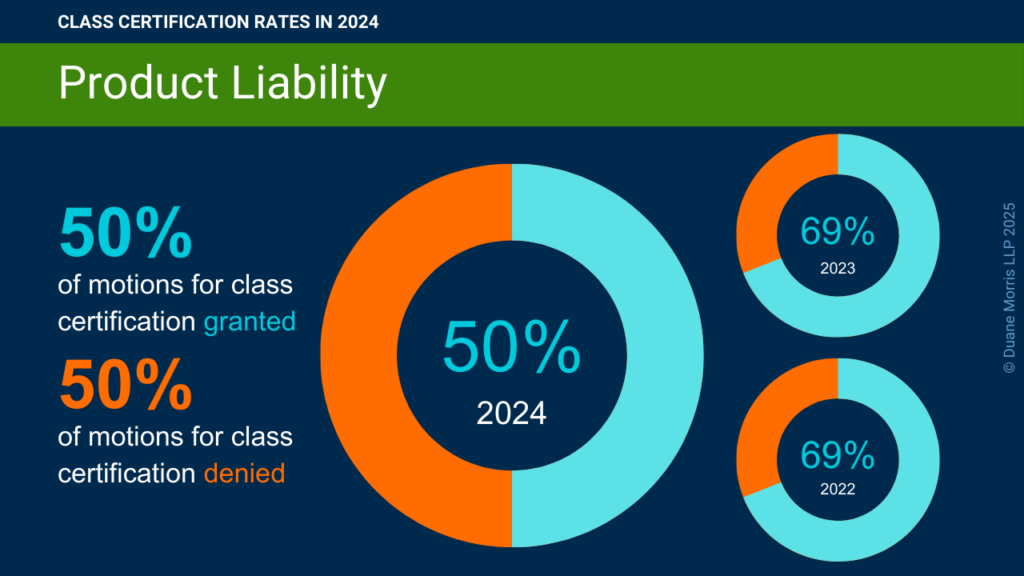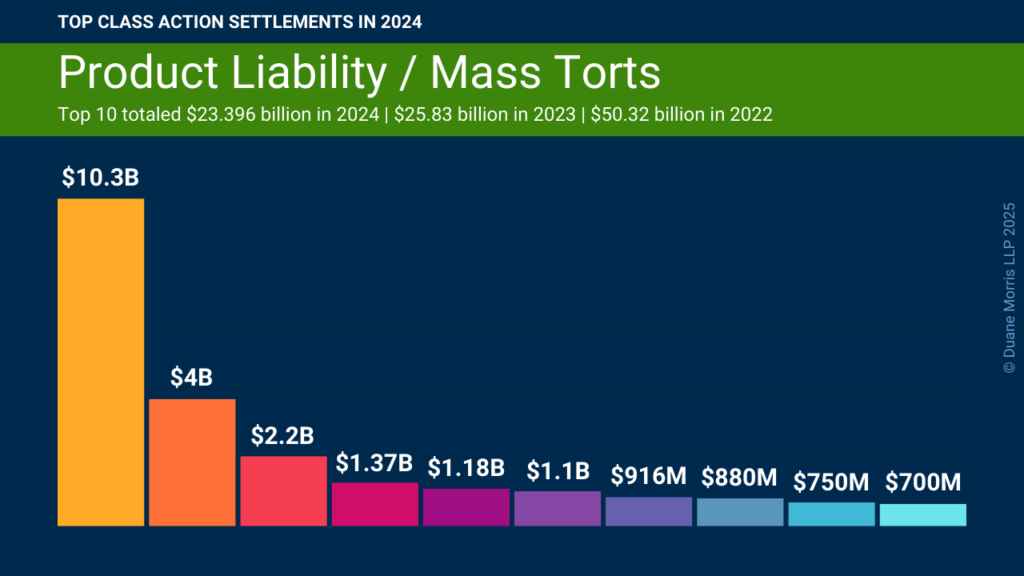
Duane Morris Takeaway: This week’s episode of the Class Action Weekly Wire features Duane Morris partner Jerry Maatman and senior associates Anne Gruner and Betty Luu with their discussion of the key trends analyzed in the 2025 edition of the Products Liability & Mass Torts Class Action Review, including notable developments in the areas of opioid and PFAS litigation in the products liability and mass tort context.
Bookmark or download the Products Liability & Mass Torts Class Action Review – 2025, which is fully searchable and viewable from any device.
Check out today’s episode and subscribe to our show from your preferred podcast platform: Spotify, Amazon Music, Apple Podcasts, Samsung Podcasts, Podcast Index, Tune In, Listen Notes, iHeartRadio, Deezer, and YouTube.
Episode Transcript
Jerry Maatman: Welcome to our listeners. Thank you for being here for our weekly podcast series, the Class Action Weekly Wire. I’m Jerry Maatman, a partner at Duane Morris, and joining me today are my colleagues, Anne and Betty – and Betty, in this instance who is joining us for the first time – thanks for being here in our podcast. This is Episode 94 of the Class Action Weekly Wire, and we’re excited to have you here while we deliver noteworthy class action content to our loyal blog listeners.
Anne Gruner: Thank you, Jerry, happy to be here and happy to be a part of this podcast.
Betty Luu: Thanks for having me, Jerry.
Jerry: So, today we’re discussing the publication of the Duane Morris Products Liability & Mass Torts Class Action Review, which we published recently on the Duane Morris Class Action Defense Blog. Anne, can you tell our listeners a bit about this desk reference?
Anne: Yes, absolutely, Jerry. Thanks. So, the Duane Morris Products Liability & Mass Torts Class Action Review for 2025 analyzes the key rulings and developments in these areas for 2024, and then also the significant legal decisions and trends impacting this type of class action litigation looking forward for 2025. We hope that companies will benefit from this resource in their compliance with the evolving laws and standards in this area.
Jerry: So, as a general rule, products liability litigation, I think, can be categorized into two types of principal claims. First are products liability class actions alleging that a product itself causes injuries to an individual or group of people in the class, and these are typically physical injury claims, like someone being harmed by an allegedly defective product. The second category involves mass tort claims that are typically an aggregation of many individual lawsuits that are managed by a judge in an MDL that feels very much like a class action. Betty, in 2024, how did the plaintiffs’ bar do in certifying products liability and mass tort class actions?
Betty: In 2024, plaintiffs had a mixed record with class certification in product liability and mass tort actions. Of the motions for class certification, 50% were granted and 50% were denied. It’s always a balancing act in these types of cases. The unique facts of each case really influence the outcome. For example, labeling-related cases might fare better for certification, because everyone involved often has the same injury – say, a health condition caused by undisclosed ingredients in a product. However, even in these cases, the individual’s medical history can play a role.

Jerry: That’s interesting. And that’s a really big change from the year before, because both in 2022 and in 2023, courts were granting motions for class certification at a rate close to 70%. And I’ve always thought the mantra of the plaintiffs’ bar is file the case, certify it, and then monetize it. So, a diminished class certification conversion rate for plaintiffs is very telling for defendants in these sorts of cases.
Let’s shift gears a little bit – one of the biggest examples of mass tort litigation in recent years has been opioid litigation. What happened in that space over the last 12 months?
Anne: Well, sure, Jerry, this is a very interesting area, as you pointed out. So, the opioid litigation is massive, and it really is an ongoing saga. It’s been consolidated since 2017, and it involves thousands of lawsuits filed by governments and individuals against manufacturers, distributors, and pharmacies. The central issue is the manufacturers allegedly downplaying the addictive nature of the opioids contributing to a public health crisis. They’ve led to billions of dollars in settlements, though some of those are still being contested. The Sixth Circuit currently, for example, is deciding whether to enforce a $650 million judgment against the pharmacies in two different Ohio counties, and has asked Ohio Supreme Court to weigh in and determine whether state law permits the public nuisance claim – a type of claim that’s asserted to address public problems such as chemical spills.
Betty: And of course, the bankruptcy proceedings for Purdue Pharma have also been a major part of ongoing opioid litigation. The U.S. Supreme Court ruled in 2024 that Purdue’s bankruptcy plan couldn’t shield the Sackler family, the owners of Purdue, from future litigation. The Sacklers were accused of personally profiting from Purdue’s aggressive marketing strategies that helped fuel the opioid epidemic. However, as part of the bankruptcy settlement, the Sacklers were seeking protection from further litigation, which would shield them from being held personally liable for the company’s role in the opioid crisis. The Supreme Court concluded that the bankruptcy code does not authorize a release or injunction as part of a Chapter 11 reorganization plan that seeks to discharge claims against a non-debtor, such as the Sacklers, without the consent of the affected claimants.
Jerry: That’s a huge, significant decision, and certainly shows the complexity of mass torts superimposed in the class action space, and how they intersect with many issues involving bankruptcy, public health issues, and settlements. As I understand it, our clients are also facing PFAS litigation, which is another huge, growing area of potential risk and liability.
Anne: Yes, absolutely. So, PFAS, or “forever chemicals” as they’re more commonly known, have become a major issue due to their environmental impact. These chemicals, which are found in products like firefighting foam, have contaminated water supplies leading to health concerns. Over 300 different lawsuits have been filed, with many consolidated into an MDL in South Carolina.
Betty: The EPA has started setting limits on PFAS in drinking water, and several states have enacted new regulations. In April 2024, the EPA finalized the ruling setting the first-ever limits for PFAS in drinking water, and is already subject to multiple legal challenges. In October of 2024, the White House Office of Science and Technology Policy said in a report that it will continue to look for new technologies to remove so-called forever chemicals from the environment in five s tates and find safe alternatives for the substances.
Jerry: Well, certainly the plaintiffs’ bar on the class action side is attracted by the potential money in these areas and our Review appropriately focuses on the leading class action settlements in this space over the past 12 months. How did plaintiffs do in terms of a scorecard of garnering large settlements in this area over the past 12 months?
Anne: Well, Jerry, plaintiffs did very well in securing high dollar settlements in 2024 – the top 10 totaled $23.396 billion. That was just a slight drop from 2023, when the top 10 settlements in the space totaled $25.83 billion. One of the top settlements of the year was for $10.3 billion to resolve claims with 3M by utilities that maintain it is liable for damage they have, and will incur, due to its signature PFAS that were used for decades in specialized fire suppressants and that were sprayed directly into the environment and reached drinking water.

Jerry: Wow, well, I guess that’s a sign of the times. We used to talk about $1 million settlements being large, and in this space, now we’re talking about $1 billion settlements. Well, thanks, Anne, and thanks, Betty, for being here today and for lending your thought leadership for our loyal listeners who tuned in to hear about our Products Liability & Mass Torts Class Action Review. Thanks so much for being here.
Anne: Absolutely. Thank you, Jerry, and thank you to all the listeners.
Betty: Thank you, Jerry, and thanks to all for tuning in to the Weekly Wire.
